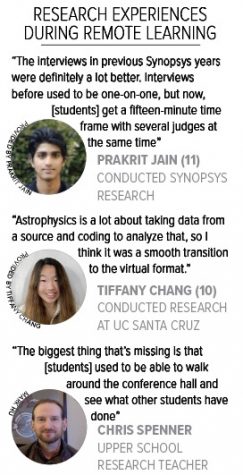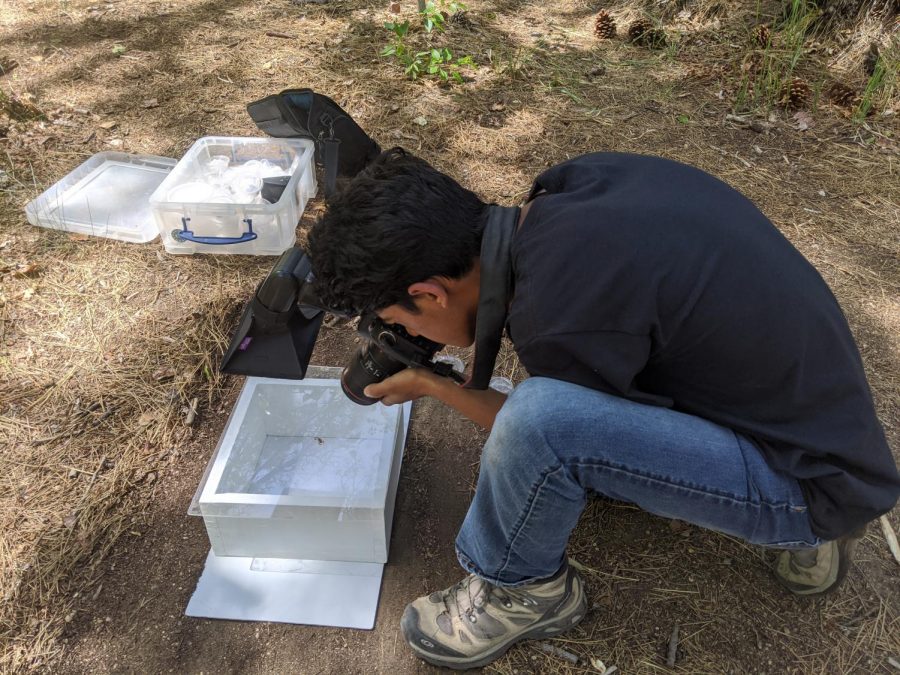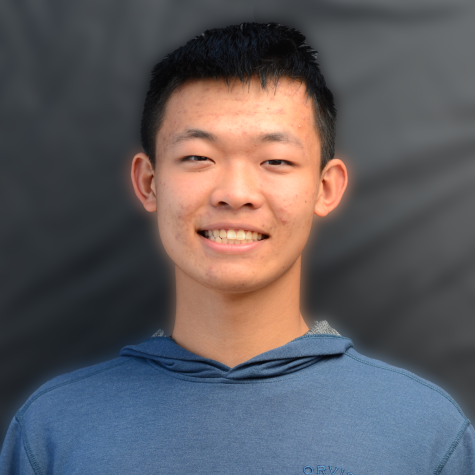Student research through the pandemic
Virtual Synopsys features science projects from the past year
Provided by Prakrit Jain
Prakrit Jain (11) photographs a sample for his project that built an automatic software to create ranged maps for wildlife.
March 23, 2021
The annual Synopsys Science & Technology Championship was held virtually on March 11, with students presenting their research from the past year to judges through online interviews and PowerPoint slides.
The Santa Clara Valley Science and Engineering Fair Association (SCVSEFA), which has historically held the competition in person at the San Jose Convention Center, shifted to a virtual format last year in response to rising COVID-19 cases.
“I think [students] still have as much of a chance to talk to the judges and meet people,” Chris Spenner, upper school research teacher and Synopsys mentor, said. “The biggest thing that’s missing is that they used to be able to walk around the conference hall and see what other students have done, and they don’t really have a chance to do that this year, which is a shame.”
Research opportunities over the summer were limited due to the pandemic, but some universities—including UC Santa Cruz, which fully operated its Science Internship Program (SIP) online—adapted to the change. Tiffany Chang (10), who worked with a professor on astrophysics research at SIP, expanded her summer research for Synopsys. Her project looked at adjusting selection criteria to differentiate between gamma rays from the source and background radiation.
“Astrophysics as a whole is a lot about taking data from a source and coding to analyze that, so I think it was a smooth transition to the virtual format,” Tiffany said. “I performed my analysis with Python code and Jupyter notebooks, and then I saw what optimizations I could make and then applied that to the data.”
When students submitted their projects for the Synopsys science fair, judging was held on an online software called RocketJudge. Contestants received time slots throughout the afternoon to meet with their judges, and they shared their corresponding files ahead of time.
“Synopsys is a really good opportunity to try to explain your project to somebody who has some sort of science or engineering background but doesn’t know a lot about the specific field,” said Prakrit Jain (11), whose research used automatic software to generate ranged maps. “It teaches us a lot about how to communicate your project, even the details, in a simple way.”

Both Tiffany and Prakrit previously conducted research with the Science Research Program (SRP), which is a program led by middle school science teachers that takes eighth graders through the entire Synopsys process. From developing a research topic and conducting experiments to writing a full report and presenting their research, they gain firsthand experience with research before entering high school . Ella Lan (9), who developed machine learning architecture for real-time surgery video analysis for her Synopsys project this year, was also a part of the SRP program.
“Not being able to be in the classroom next to a mentor and being able to go up to them and ask them questions in real life is definitely something that I had taken for granted last year,” Ella said. “I think one of the main changes was using more online resources, like open source frameworks, and doing more of my own in depth research.”
As a result of going completely online and losing in-person interaction, several elements of the competition itself were also affected.
“The interviews in previous Synopsys years were definitely a lot better. One of the main things is that the interviews before used to be one-on-one, but now, [students] get a fifteen-minute time frame with several judges at the same time,” Prakrit said. “It’s definitely much easier to try to explain your project to one judge at a time. Also, you can learn from your previous interactions with judges to try to make the next presentation a bit better.”
In addition, because students were required to share required files and power points with judges ahead of time, the ability to explain your project as a whole was lost.
“This year, given the fact that [judges] were able to read [my project] ahead of time, they were able to conduct specific questions to target my understanding,” Ella said. “The good thing was that now they understood the basic part of my project, so I was able to go more in depth, but the downside was that I was unable to see their reaction in their faces as they had already composed themselves by the time of the interview.”
Winners will be posted on the Synopsys science fair website, and contestants that qualified to the 2021 California Science & Engineering Fair (CSEF), which will be held on April 12 and 13, are listed at the following link and will receive an email for registration details.


















![“[Building nerf blasters] became this outlet of creativity for me that hasn't been matched by anything else. The process [of] making a build complete to your desire is such a painstakingly difficult process, but I've had to learn from [the skills needed from] soldering to proper painting. There's so many different options for everything, if you think about it, it exists. The best part is [that] if it doesn't exist, you can build it yourself," Ishaan Parate said.](https://harkeraquila.com/wp-content/uploads/2022/08/DSC_8149-900x604.jpg)




![“When I came into high school, I was ready to be a follower. But DECA was a game changer for me. It helped me overcome my fear of public speaking, and it's played such a major role in who I've become today. To be able to successfully lead a chapter of 150 students, an officer team and be one of the upperclassmen I once really admired is something I'm [really] proud of,” Anvitha Tummala ('21) said.](https://harkeraquila.com/wp-content/uploads/2021/07/Screen-Shot-2021-07-25-at-9.50.05-AM-900x594.png)







![“I think getting up in the morning and having a sense of purpose [is exciting]. I think without a certain amount of drive, life is kind of obsolete and mundane, and I think having that every single day is what makes each day unique and kind of makes life exciting,” Neymika Jain (12) said.](https://harkeraquila.com/wp-content/uploads/2017/06/Screen-Shot-2017-06-03-at-4.54.16-PM.png)








![“My slogan is ‘slow feet, don’t eat, and I’m hungry.’ You need to run fast to get where you are–you aren't going to get those championships if you aren't fast,” Angel Cervantes (12) said. “I want to do well in school on my tests and in track and win championships for my team. I live by that, [and] I can do that anywhere: in the classroom or on the field.”](https://harkeraquila.com/wp-content/uploads/2018/06/DSC5146-900x601.jpg)
![“[Volleyball has] taught me how to fall correctly, and another thing it taught is that you don’t have to be the best at something to be good at it. If you just hit the ball in a smart way, then it still scores points and you’re good at it. You could be a background player and still make a much bigger impact on the team than you would think,” Anya Gert (’20) said.](https://harkeraquila.com/wp-content/uploads/2020/06/AnnaGert_JinTuan_HoHPhotoEdited-600x900.jpeg)

![“I'm not nearly there yet, but [my confidence has] definitely been getting better since I was pretty shy and timid coming into Harker my freshman year. I know that there's a lot of people that are really confident in what they do, and I really admire them. Everyone's so driven and that has really pushed me to kind of try to find my own place in high school and be more confident,” Alyssa Huang (’20) said.](https://harkeraquila.com/wp-content/uploads/2020/06/AlyssaHuang_EmilyChen_HoHPhoto-900x749.jpeg)







